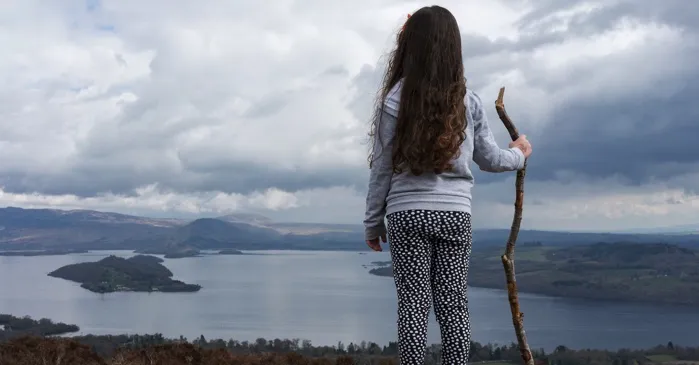
Roughing It: The Appeal of Survivalist Kids’ Books
Towards the end of 2019 (you know, in the Before), a few friends and I finally decided to do something we’d been talking about for years, and reread the Little House series together. Since we all lived in different places, we agreed to read one book a month and then discuss via email. We’d gotten through a handful of books when COVID-19 hit, and since everyone was Zooming, our casual read-along turned into a monthly book club — and since there was nothing else to do, we kept it up even after we’d finished the series. Laura Ingalls Wilder was followed by her fellow pioneer girl Caddie Woodlawn, and then the first Boxcar Children book. At first we were just picking books we’d read and loved when we were younger, but without entirely planning it, our book club developed a more specific theme: survivalist books for kids.
Maybe that’s a melodramatic way to describe it, but I bet you know what I mean: children’s books about roughing it in the wilderness, whether it’s a temporary, ridiculous crisis (The Baby-sitters Club Super Special #4: Baby-sitters’ Island Adventure) or a serious battle for survival (Hatchet) or a fun experiment embarked upon deliberately (My Side of the Mountain). Some of these have been around since the ’20s, some were published when we were growing up in the ’90s, but they all feature kids making shelters and learning to start fires and so on, usually without any adult supervision whatsoever.
Why did these books appeal to us as kids, so much so that I’ve happily been rereading a different one every month for over a year now? I can’t speak for all of my fellow book club members, but I was a firmly urban kid who did not enjoy camping, bugs, the dark, being afraid, eating anything off of my narrow list of acceptable foods, or being separated from my book collection. And yet I devoured stories that contained all of these things. Washing my clothes in a stream? Living on questionable berries and fish that I caught with a sharpened stick? As long as I’m only doing it vicariously through fiction, sign me up!
An obvious part of the appeal, I think, is the same reason kids like books about orphans: no grownups there to tell you what to do. There’s no bedtime when you’re stranded on an island with four babies (Baby Island) or living in a boxcar! The fantasy of complete autonomy is a compelling one when your age is still in single digits (or even as an adult, let’s be honest).
And not just autonomy, but competence. Though these books describe fears and failures, the kids always obviously survive. Not only does the child reader get the pleasure of seeing kids doing whatever they want, they also get the pleasure of seeing them be good at it. Yes, Dawn and Claudia and their sitting charges end up on an island due to a sailing mishap in Island Adventure, but they also invent a useable water collecting device out of a tarp. Yes, the extremely boring protagonist of Hatchet eats a lot of poisonous berries, but he a) doesn’t die and b) finds regular edible raspberries. I could do that too, probably! (Maybe. Okay, probably not.)
Which brings me to the food. You wouldn’t think these books are satisfying on the culinary front — we’re not talking Redwall-style feasts here — but something about struggling for sustenance makes even the paltry, scrounged meals in these kinds of books sound amazing even if, as an adult who knows how to cook, I suspect that everything described is borderline inedible without salt, and also all of those kids are anemic now. Let me imagine that random tiny fish burnt to a crisp over an open flame is actually delicious, okay?
Plus, if the survivalist kid protagonists play their cards right, they might even tame an animal companion, like a wild dog (Island of the Blue Dolphins) or peregrine falcon (My Side of the Mountain). Those are way better pets than a hamster or whatever regular kids who live in houses have.
This funky little sub-genre isn’t perfect, of course. Some of the books are truly silly (hello again, Baby Island), while the ones that lean too hard into plausibility can get dull and impersonal fast (hello…every single one of these I’ve read with a boy protagonist). More importantly, it bears pointing out that this sub-genre is a very white one, and some of its mainstays are awfully problematic — I loved Island of the Blue Dolphins and Julie of the Wolves as a kid, but they are full of inaccuracies and stereotypes.
But for those books that don’t reinforce racist tropes, I hope kids today are still using them to enjoy the fantasy of living off the land, free from parental judgment or the threat of vitamin deficiency. It’s a safe way to explore notions of autonomy and being responsible for your own survival, years before you actually have to worry about them (I hope)…and maybe even learn a little bit about berry safety or animal husbandry in the process.
And hey, for us urban indoor kid runaways, there’s always The Secret Files of Mrs. Basil E. Frankweiler.
- Middle Grade Books About Music, Bands and Musicals
- My Daughter’s Male World and the Books That Reinforce It
- 15 Diverse Picture Book Biographies
- Indestructible Books for Curious Kids
- Children’s Books That Contextualize, Correct, or Challenge Classic Kid Lit
- 8 Middle Grade Books With Latinx Characters
- Top Streaming Movies and Shows Based on Children’s Books
- Quiz: What Classic Middle Grade Character Are You?
- Great Early Chapter Books For Your Emerging Reader!
